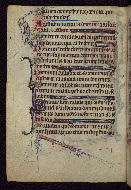The Genesis of a Medieval Manuscript
lquigley
«Previous page
•Page 1
•Page 2
•Page 3
•Page 4
•Page 5
•Page 6
•Page 7
•Page 8
•Page 9
•Page 10
•Page 11
•Page 12
•Page 13
•Page 14
•Page 15
You are here •Page 16 •Page 17 •Page 18 •Page 19 •Page 20 •Page 21 •Page 22 ♦Endnotes »Next page
You are here •Page 16 •Page 17 •Page 18 •Page 19 •Page 20 •Page 21 •Page 22 ♦Endnotes »Next page
109

|
|
Correction:
The text would then pass to another scribe to begin the correction process. This was generally not done by the scribe responsible for the initial transcription of the manuscript; instead, a "corrector" would subject "the entire text to comparison with the exemplar from which it had been copied so that mistakes could be spotted and rectified". These correctors were generally older members of the scriptorium, all with more "textual familiarity and insight" than the younger members responsible for transcription (Graham and Clemens 35). Surviving medieval manuscripts display a wide range of mistakes, from eyeskip to dittography to inversion of word order. Eyeskip occured when the same "word, phrase, or sequence of letters appeared twice in close succession" in the exemplar, causing the scribe to lose his place in the process and skip sections of the text. This error has several subcategories: if it involves two words beginning with the same letters, it is termed homoeoarcton; if the words end in the same letters, homoeoteleuton (Graham and Clemens 35). Dittography is the opposite error; after copying an entire passage, a scribe might accidentally recopy it due to a similar word order. The inversion of word order is easily understood, and occurred relatively frequently within medieval texts. A corrector's job included using erasure and subpunction to fix many of these mistakes. For incorrect letters or even entire phrases, the corrector might use a penknife to scrape away the offending ink and replace it with his own correct insertion. This method is responsible for much of the cramped text found amongst medieval manuscripts; after erasing a mistake, the corrector might have to write in very small print to fit the correct phrase in the available space. Correctors might also place a series of dots under incorrect letters, then write the corrected letters immediately above them. If the error involved inverting word order, the correcting scribe would frequently write an "a" and a "b" above the reversed words to indicate which was to be read first. Marginal corrections were also common, using signes-de-renvoi to match the error to the marginal correction, much in the same manner that modern-day asterisks (*) match segments of the text to footnotes. These only came into common usage after the tenth century, however; prior to this, correctors would add hd or hs next to a mistake, directing the reader to look downward (hd: hic deorsum) or upward (hs: hic sursum). After completing correction, the manuscript would move onto the glossing stage. The example to the left contains a correction made by a scribe five lines from the bottom on the fifth letter. |

|



